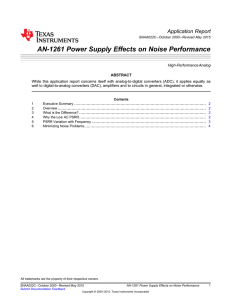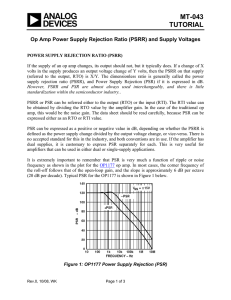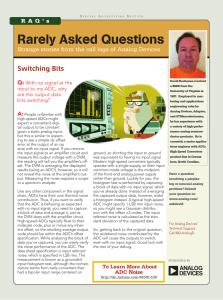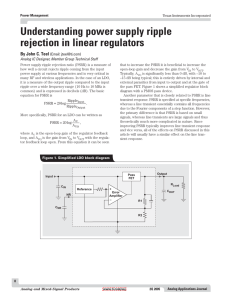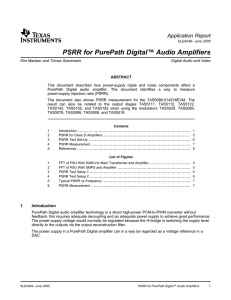ADC12040 Application Note 1261 Power Supply Effects on Noise Performance
advertisement
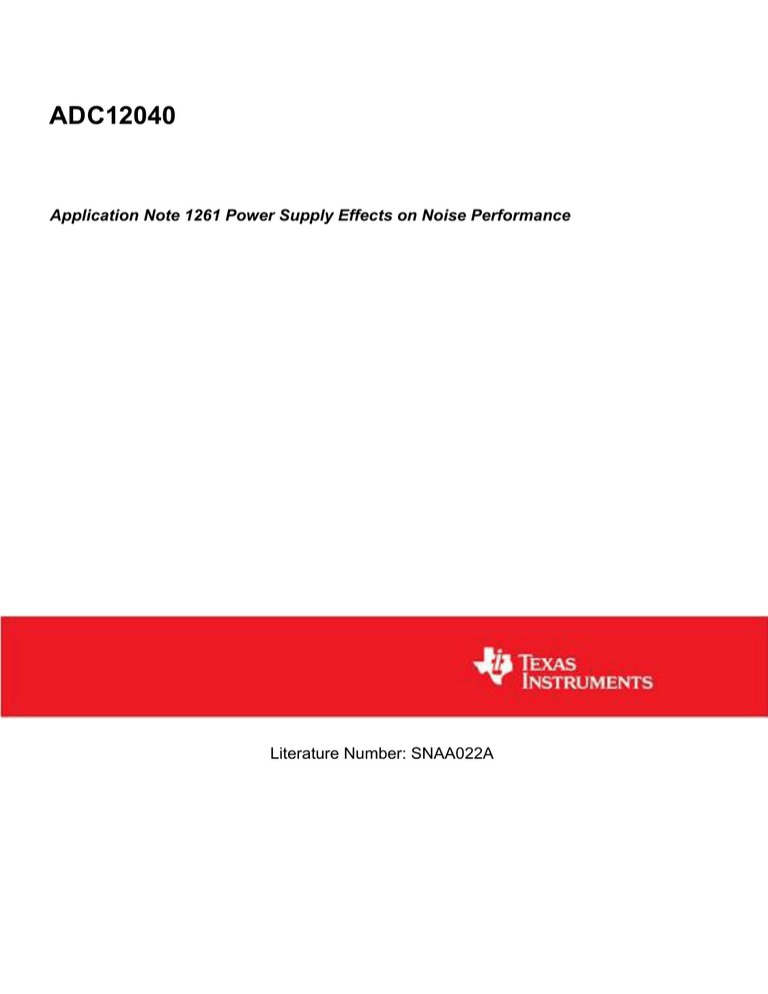
ADC12040 Application Note 1261 Power Supply Effects on Noise Performance Literature Number: SNAA022A National Semiconductor Application Note 1261 Nicholas Gray March 2007 Executive Summary Why the Low AC PSRR PSRR is an often misunderstood and little used specification. Understanding the PSRR (Power Supply Rejection Ratio) of analog circuits is an important step toward improving overall mixed-signal system performance. The fact is that the PSRR of analog circuits, including ADCs (Analog-to-Digital Converters), DACs (Digital-to-Analog Converters) and op amps, is usually much worse at high frequencies than the DC PSRR generally seen on data sheets. However, most manufacturers have historically only specified DC PSRR. While this application note concerns itself with Analog-to-Digital Converters, it applies equally as well to Digital-to-Analog Converters, amplifiers and to circuits in general, integrated or otherwise. Product Applicability: All ADCs and DACs Any signal or noise on the supply lines will couple into the active circuitry through the stray capacitances and gain of the bias network and be amplified by the active circuitry on the die. These unwanted signals are noise and, therefore, degrade the device’s noise performance. Figure 1 shows a simplified amplifier stage with stray capacitances. Actual circuits use many techniques to improve PSRR, but no analog circuit is totally immune to supply noise. One source of power supply noise comes from the output switching of an ADC. The change of output states will cause supply current transients as the output drivers charge the capacitance on the output pins. Overview In general, the Power Supply Rejection Ratio (PSRR) of integrated circuits, when specified, indicates how well that device rejects a change in the DC power supply voltage. It describes the change in a given specification, such as input offset, for a given change in the power supply DC voltage. This is what we here call DC PSRR and does not tell us anything about how well the device will reject the effects of a dynamic signal on the power supply, which we here call AC PSRR. Power Supply Effects on Noise Performance Power Supply Effects on Noise Performance What is the Difference? The difference between AC PSRR and DC PSRR the way these two parameters are specified. Most products’ PSRR specification indicates DC PSRR, or the variation in a particular parameter for a given change in DC power supply voltage. For example, an ADC may specify the PSRR as the ratio of the change in full-scale gain or offset error with a given change in the DC supply voltage, usually expressed in dB. If a change in supply voltage from 4.75V to 5.25V (a 500mV delta) results in a change in the full-scale ADC gain error of 0.6mV, the PSRR is found to be 20056402 FIGURE 1. Supply noise can couple into the active circuitry of a device and degrade its performance Without adequate supply bypassing, these current transients will cause voltage fluctuations on the supply line. The resulting high frequency noise on the supply line causes noise in the bias circuitry, which further degrades the SNR of the ADC. PSRR Variation with Frequency © 2007 National Semiconductor Corporation 200564 Figure 2 shows a plot of AC PSRR for the ADC12040 (a 12bit, 40Msps ADC) vs. supply noise frequency. The test data for this plot was gathered by injecting 200mVP-P of at various frequencies onto the power supply lines of the ADC and using a frequency domain (FFT) plot to measure the magnitude of this signal at the output of the ADC. With 38dB AC PSRR at 30MHz, the ADC12040’s performance is actually quite good. Analog components often have PSRRs in the 10 to 20 dB range at these frequencies. AN-1261 That is, the difference in gain error is determined by taking two gain error measurements. One reading is taken with a stable, noise-free supply of 4.75V and the other is with a stable, noise-free supply of 5.25V. This information only shows how this one specified parameter can be expected to change with individual power supply variations. However, other parameters may have more or less sensitivity to noise on the power supply, so the usefulness of such a specification is questionable. AC PSRR, on the other hand, indicates how well a circuit rejects a dynamic signal at a specified frequency is from its output. Generally, the PSRR of an active component will be worse with an AC signal riding on its supply than it will be with a change of the power DC level of the supply. www.national.com AN-1261 20056403 20056404 FIGURE 2. Plot of PSRR vs. supply noise frequency for the ADC12040 FIGURE 3. Separately bypass the power supply at both low and high frequencies. Isolate digital output driver supply line with a small choke. A ferrite choke with 2.5 turns will do well. Minimizing Noise Problems To minimize the effects of noise on the power supply, the analog and digital supply pins should be separately decoupled for both high and low frequencies. Typically, a parallel combination of a 10µF capacitor and a 0.1µF monolithic capacitor will suffice. The optimum values may vary with the particular IC selected and the frequency of operation, so be sure to follow the manufacturer’s recommendations. Additionally, for mixed-signal products such as ADCs, it is good practice to bring the power directly to the analog supply pins first, then to the digital supply pins through a choke. For highspeed ADCs, a ferrite choke with 2.5 turns will do well. The choke usually only needs to isolate the output driver pins from the other supply pins. If the output driver supply pins are not explicitly shown on the data sheet, isolate all of the digital supply pins. In any case, the analog and digital supply pins of a mixed signal device should have separate bypass capacitors as shown in Figure 3. www.national.com Finally, as popular as they are for their efficiency, the noise generated by switching power supplies can wreak havoc with mixed signal components. If it is necessary to have a switching supply in the system, be sure to lay out the board for minimum RFI/EMI and keep it as far away from analog and mixed signal areas of the system as possible. The power supply for analog and mixed-signal components should be filtered well. Keep in mind that switching supplies typically have ringing frequencies in the hundreds of Megahertz which can be difficult to filter out because of the ESL of a lumped capacitance. Using a linear regulator, such as an LDO (low drop out regulator), between a switching supply and the linear or mixed-signal circuit may not solve this problem because that regulator may not have a high enough PSRR at the high ringing frequencies to be effective. 2 AN-1261 Notes 3 www.national.com Power Supply Effects on Noise Performance Notes THE CONTENTS OF THIS DOCUMENT ARE PROVIDED IN CONNECTION WITH NATIONAL SEMICONDUCTOR CORPORATION (“NATIONAL”) PRODUCTS. NATIONAL MAKES NO REPRESENTATIONS OR WARRANTIES WITH RESPECT TO THE ACCURACY OR COMPLETENESS OF THE CONTENTS OF THIS PUBLICATION AND RESERVES THE RIGHT TO MAKE CHANGES TO SPECIFICATIONS AND PRODUCT DESCRIPTIONS AT ANY TIME WITHOUT NOTICE. NO LICENSE, WHETHER EXPRESS, IMPLIED, ARISING BY ESTOPPEL OR OTHERWISE, TO ANY INTELLECTUAL PROPERTY RIGHTS IS GRANTED BY THIS DOCUMENT. TESTING AND OTHER QUALITY CONTROLS ARE USED TO THE EXTENT NATIONAL DEEMS NECESSARY TO SUPPORT NATIONAL’S PRODUCT WARRANTY. EXCEPT WHERE MANDATED BY GOVERNMENT REQUIREMENTS, TESTING OF ALL PARAMETERS OF EACH PRODUCT IS NOT NECESSARILY PERFORMED. NATIONAL ASSUMES NO LIABILITY FOR APPLICATIONS ASSISTANCE OR BUYER PRODUCT DESIGN. BUYERS ARE RESPONSIBLE FOR THEIR PRODUCTS AND APPLICATIONS USING NATIONAL COMPONENTS. PRIOR TO USING OR DISTRIBUTING ANY PRODUCTS THAT INCLUDE NATIONAL COMPONENTS, BUYERS SHOULD PROVIDE ADEQUATE DESIGN, TESTING AND OPERATING SAFEGUARDS. EXCEPT AS PROVIDED IN NATIONAL’S TERMS AND CONDITIONS OF SALE FOR SUCH PRODUCTS, NATIONAL ASSUMES NO LIABILITY WHATSOEVER, AND NATIONAL DISCLAIMS ANY EXPRESS OR IMPLIED WARRANTY RELATING TO THE SALE AND/OR USE OF NATIONAL PRODUCTS INCLUDING LIABILITY OR WARRANTIES RELATING TO FITNESS FOR A PARTICULAR PURPOSE, MERCHANTABILITY, OR INFRINGEMENT OF ANY PATENT, COPYRIGHT OR OTHER INTELLECTUAL PROPERTY RIGHT. LIFE SUPPORT POLICY NATIONAL’S PRODUCTS ARE NOT AUTHORIZED FOR USE AS CRITICAL COMPONENTS IN LIFE SUPPORT DEVICES OR SYSTEMS WITHOUT THE EXPRESS PRIOR WRITTEN APPROVAL OF THE CHIEF EXECUTIVE OFFICER AND GENERAL COUNSEL OF NATIONAL SEMICONDUCTOR CORPORATION. As used herein: Life support devices or systems are devices which (a) are intended for surgical implant into the body, or (b) support or sustain life and whose failure to perform when properly used in accordance with instructions for use provided in the labeling can be reasonably expected to result in a significant injury to the user. A critical component is any component in a life support device or system whose failure to perform can be reasonably expected to cause the failure of the life support device or system or to affect its safety or effectiveness. National Semiconductor and the National Semiconductor logo are registered trademarks of National Semiconductor Corporation. All other brand or product names may be trademarks or registered trademarks of their respective holders. Copyright© 2007 National Semiconductor Corporation AN-1261 For the most current product information visit us at www.national.com National Semiconductor Americas Customer Support Center Email: new.feedback@nsc.com Tel: 1-800-272-9959 www.national.com National Semiconductor Europe Customer Support Center Fax: +49 (0) 180-530-85-86 Email: europe.support@nsc.com Deutsch Tel: +49 (0) 69 9508 6208 English Tel: +49 (0) 870 24 0 2171 Français Tel: +33 (0) 1 41 91 8790 National Semiconductor Asia Pacific Customer Support Center Email: ap.support@nsc.com National Semiconductor Japan Customer Support Center Fax: 81-3-5639-7507 Email: jpn.feedback@nsc.com Tel: 81-3-5639-7560 IMPORTANT NOTICE Texas Instruments Incorporated and its subsidiaries (TI) reserve the right to make corrections, modifications, enhancements, improvements, and other changes to its products and services at any time and to discontinue any product or service without notice. Customers should obtain the latest relevant information before placing orders and should verify that such information is current and complete. All products are sold subject to TI’s terms and conditions of sale supplied at the time of order acknowledgment. TI warrants performance of its hardware products to the specifications applicable at the time of sale in accordance with TI’s standard warranty. Testing and other quality control techniques are used to the extent TI deems necessary to support this warranty. Except where mandated by government requirements, testing of all parameters of each product is not necessarily performed. TI assumes no liability for applications assistance or customer product design. Customers are responsible for their products and applications using TI components. To minimize the risks associated with customer products and applications, customers should provide adequate design and operating safeguards. TI does not warrant or represent that any license, either express or implied, is granted under any TI patent right, copyright, mask work right, or other TI intellectual property right relating to any combination, machine, or process in which TI products or services are used. Information published by TI regarding third-party products or services does not constitute a license from TI to use such products or services or a warranty or endorsement thereof. Use of such information may require a license from a third party under the patents or other intellectual property of the third party, or a license from TI under the patents or other intellectual property of TI. Reproduction of TI information in TI data books or data sheets is permissible only if reproduction is without alteration and is accompanied by all associated warranties, conditions, limitations, and notices. Reproduction of this information with alteration is an unfair and deceptive business practice. TI is not responsible or liable for such altered documentation. Information of third parties may be subject to additional restrictions. Resale of TI products or services with statements different from or beyond the parameters stated by TI for that product or service voids all express and any implied warranties for the associated TI product or service and is an unfair and deceptive business practice. TI is not responsible or liable for any such statements. TI products are not authorized for use in safety-critical applications (such as life support) where a failure of the TI product would reasonably be expected to cause severe personal injury or death, unless officers of the parties have executed an agreement specifically governing such use. Buyers represent that they have all necessary expertise in the safety and regulatory ramifications of their applications, and acknowledge and agree that they are solely responsible for all legal, regulatory and safety-related requirements concerning their products and any use of TI products in such safety-critical applications, notwithstanding any applications-related information or support that may be provided by TI. Further, Buyers must fully indemnify TI and its representatives against any damages arising out of the use of TI products in such safety-critical applications. TI products are neither designed nor intended for use in military/aerospace applications or environments unless the TI products are specifically designated by TI as military-grade or "enhanced plastic." Only products designated by TI as military-grade meet military specifications. Buyers acknowledge and agree that any such use of TI products which TI has not designated as military-grade is solely at the Buyer's risk, and that they are solely responsible for compliance with all legal and regulatory requirements in connection with such use. TI products are neither designed nor intended for use in automotive applications or environments unless the specific TI products are designated by TI as compliant with ISO/TS 16949 requirements. Buyers acknowledge and agree that, if they use any non-designated products in automotive applications, TI will not be responsible for any failure to meet such requirements. Following are URLs where you can obtain information on other Texas Instruments products and application solutions: Products Applications Audio www.ti.com/audio Communications and Telecom www.ti.com/communications Amplifiers amplifier.ti.com Computers and Peripherals www.ti.com/computers Data Converters dataconverter.ti.com Consumer Electronics www.ti.com/consumer-apps DLP® Products www.dlp.com Energy and Lighting www.ti.com/energy DSP dsp.ti.com Industrial www.ti.com/industrial Clocks and Timers www.ti.com/clocks Medical www.ti.com/medical Interface interface.ti.com Security www.ti.com/security Logic logic.ti.com Space, Avionics and Defense www.ti.com/space-avionics-defense Power Mgmt power.ti.com Transportation and Automotive www.ti.com/automotive Microcontrollers microcontroller.ti.com Video and Imaging RFID www.ti-rfid.com OMAP Mobile Processors www.ti.com/omap Wireless Connectivity www.ti.com/wirelessconnectivity TI E2E Community Home Page www.ti.com/video e2e.ti.com Mailing Address: Texas Instruments, Post Office Box 655303, Dallas, Texas 75265 Copyright © 2011, Texas Instruments Incorporated
